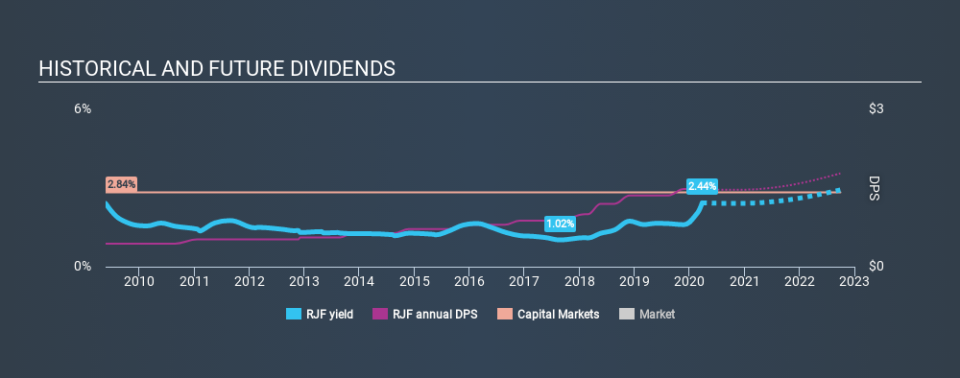Why You Might Be Interested In Raymond James Financial, Inc. (NYSE:RJF) For Its Upcoming Dividend

Raymond James Financial, Inc. (NYSE:RJF) stock is about to trade ex-dividend in 4 days time. You will need to purchase shares before the 31st of March to receive the dividend, which will be paid on the 15th of April.
Raymond James Financial's upcoming dividend is US$0.37 a share, following on from the last 12 months, when the company distributed a total of US$1.48 per share to shareholders. Based on the last year's worth of payments, Raymond James Financial has a trailing yield of 2.4% on the current stock price of $60.78. We love seeing companies pay a dividend, but it's also important to be sure that laying the golden eggs isn't going to kill our golden goose! As a result, readers should always check whether Raymond James Financial has been able to grow its dividends, or if the dividend might be cut.
See our latest analysis for Raymond James Financial
If a company pays out more in dividends than it earned, then the dividend might become unsustainable - hardly an ideal situation. Raymond James Financial has a low and conservative payout ratio of just 18% of its income after tax.
Companies that pay out less in dividends than they earn in profits generally have more sustainable dividends. The lower the payout ratio, the more wiggle room the business has before it could be forced to cut the dividend.
Click here to see the company's payout ratio, plus analyst estimates of its future dividends.
Have Earnings And Dividends Been Growing?
Stocks in companies that generate sustainable earnings growth often make the best dividend prospects, as it is easier to lift the dividend when earnings are rising. Investors love dividends, so if earnings fall and the dividend is reduced, expect a stock to be sold off heavily at the same time. Fortunately for readers, Raymond James Financial's earnings per share have been growing at 17% a year for the past five years.
Many investors will assess a company's dividend performance by evaluating how much the dividend payments have changed over time. Raymond James Financial has delivered an average of 13% per year annual increase in its dividend, based on the past ten years of dividend payments. It's great to see earnings per share growing rapidly over several years, and dividends per share growing right along with it.
Final Takeaway
From a dividend perspective, should investors buy or avoid Raymond James Financial? When companies are growing rapidly and retaining a majority of the profits within the business, it's usually a sign that reinvesting earnings creates more value than paying dividends to shareholders. Perhaps even more importantly - this can sometimes signal management is focused on the long term future of the business. Raymond James Financial ticks a lot of boxes for us from a dividend perspective, and we think these characteristics should mark the company as deserving of further attention.
On that note, you'll want to research what risks Raymond James Financial is facing. For example - Raymond James Financial has 1 warning sign we think you should be aware of.
If you're in the market for dividend stocks, we recommend checking our list of top dividend stocks with a greater than 2% yield and an upcoming dividend.
If you spot an error that warrants correction, please contact the editor at editorial-team@simplywallst.com. This article by Simply Wall St is general in nature. It does not constitute a recommendation to buy or sell any stock, and does not take account of your objectives, or your financial situation. Simply Wall St has no position in the stocks mentioned.
We aim to bring you long-term focused research analysis driven by fundamental data. Note that our analysis may not factor in the latest price-sensitive company announcements or qualitative material. Thank you for reading.

 Yahoo Finance
Yahoo Finance 
